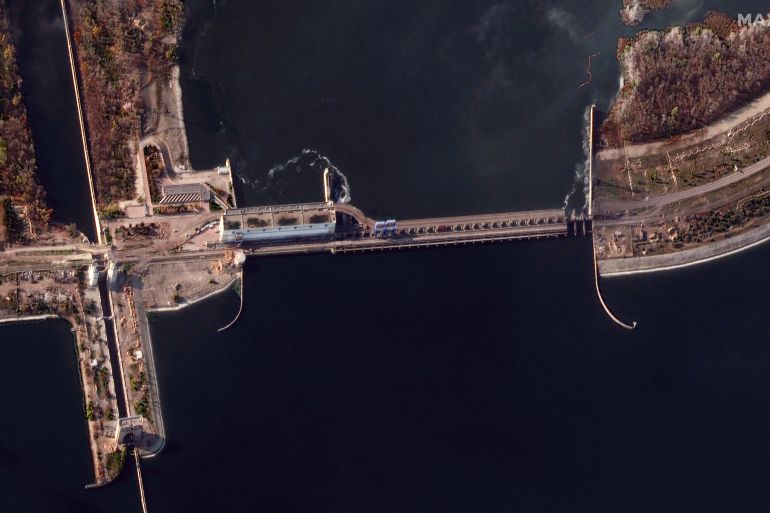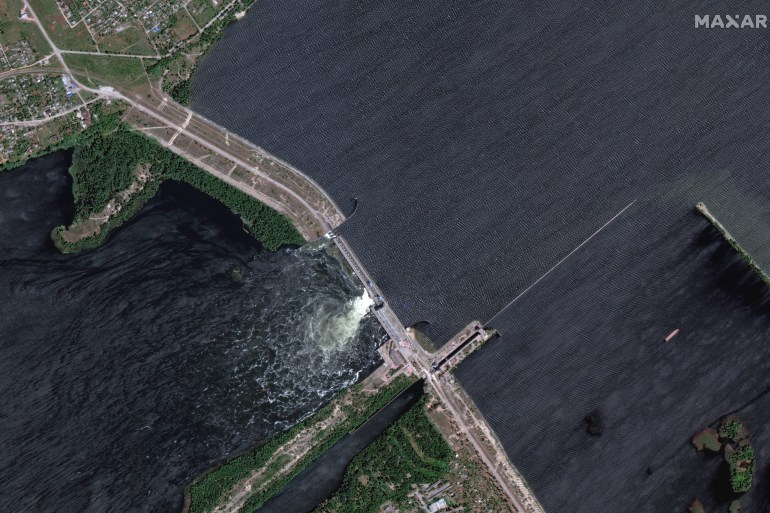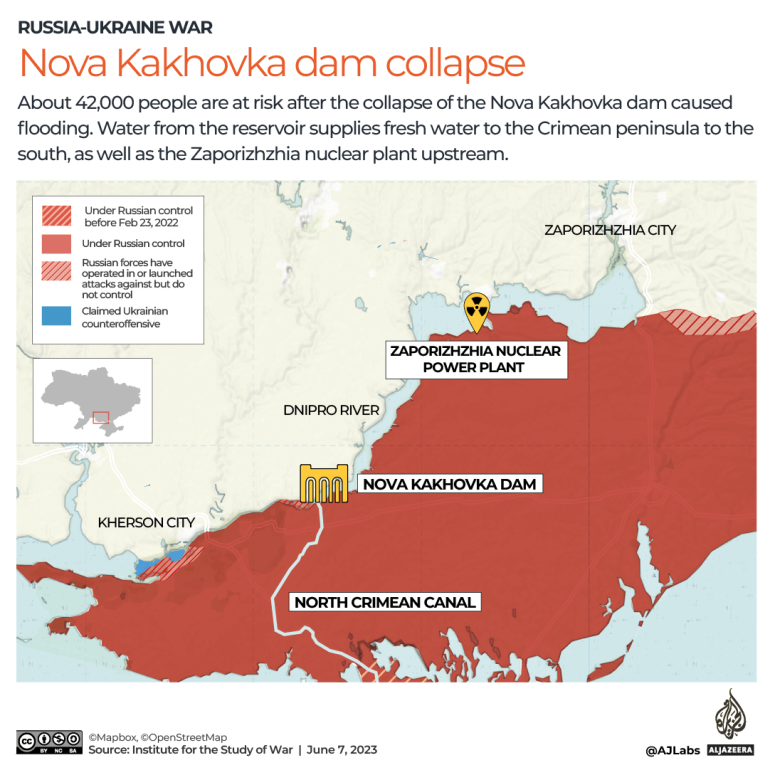Nova Kakhovka dam blast: Is Russia trying to freeze the war?
Russia could have blown up the dam in an effort to stall Ukraine’s counteroffensive, experts say.

Kyiv, Ukraine – Lilya Pshenichnaya’s old apartment building in Kherson has not been flooded.
It stands high above the right bank of the Dnipro river in the administrative centre of the eponymous southern Ukrainian region that was occupied by Russia days after the war began more than a year ago.
Keep reading
list of 4 itemsPhotos: Hundreds evacuated after Nova Kakhovka dam blast
Ukraine’s Zelenskyy says dam blast will not stop military plans
Before and after: Satellite images show Kakhovka dam destruction
Russian forces withdrew from the city in November, but still control the river’s lower, left bank, which has been flooded after the giant Nova Kakhovka dam collapsed early on Tuesday.
“There’s nothing but trouble, everything is flooded, villages and forests,” Pshenichnaya told Al Jazeera from the safety of Odesa, a Black Sea port 200km (124 miles) west of Kherson, where she relocated after months in Russian captivity.
Some low-lying parts of her hometown are also underwater, but evacuation efforts are thwarted by Russian bombing from the left bank – as landmines planted by retreating Russians months ago float up.
“Our guys move around on boats, but they are being bombed, mines pop up, all the mined areas are spontaneously being blown up,” Pshenichnaya said.
Moscow and Kyiv have accused each other of destroying the dam, which held together Ukraine’s largest water reservoir and provided water to millions.
The dam was “blasted from within”, Ukrainian President Volodymyr Zelenskyy said on Tuesday.

He called the dam’s collapse in the Russia-controlled part of the Kherson region an “environmental bomb of mass destruction”.
Moscow claimed the destruction was a “pre-planned diversion of the Ukrainian side”.
On Wednesday, Russian President Vladimir Putin cast the alleged attack as a “barbaric” act.
Germany has blamed Russia for blowing up the dam, unlike the United States and United Kingdom, which are said to be investigating the incident.

As water contaminated by oil and industrial chemicals floods downstream communities, a question looms: If Russia was responsible, would such a disaster benefit the Kremlin?
“The Kremlin’s logic is to demand a truce, among other things – either to save people on the left bank, or for nuclear blackmail,” Igar Tyshkevich, a Kyiv-based analyst, told Al Jazeera.
The dam ensured water supply to the cooling ponds of the Zaporizhzhia Nuclear Power Plant, Europe’s largest, some 150km (93 miles) northeast.
Russian servicemen seized the station more than a year ago, and Moscow often claims that Kyiv is shelling it – risking a new, much larger Chernobyl-like episode that could poison much of Eastern Europe with radiation.
And amid Moscow’s faltering war effort, Putin desperately needs time to have more men mobilised and trained and more arms manufactured.
“For Putin, a freeze of any shape or size is utterly important,” Tyshkevich said.
The dam disaster has taken place in the south, an area where Ukrainian troops are expected to focus counterattacks, a military analyst said.
The road above the dam – damaged by shelling but still passable – served as the only way of transporting Ukrainian troops and weaponry across the Dnipro, one of Europe’s largest and widest rivers.
“From the viewpoint of planning military operations, everything looked logical,” Nikolay Mitrokhin of Germany’s Bremen University told Al Jazeera.
Ukraine was aiming to regain control of the dam to begin moving armoured vehicles and heavy weaponry to the left bank – but now, floodwaters will make soil swampy for weeks to come.
“Without armoured vehicles, Ukrainian forces will lose their main trump card – mobility in a deep breakthrough,” Mitrokhin said.
So, by blowing up the dam, Russian forces secured their southern flank and can now concentrate on repelling Ukraine’s offensive in the Zaporizhia region, he said.
“From the military viewpoint, it’s pretty smart and thwarts all the plans of Ukraine’s top brass,” he said. “Unsurprisingly, Ukraine took a time out in the offensive.”
‘A Poem of the Sea’
Seven decades ago, the emergence of the Nova Kakhovka dam and a sea of fresh water behind it was hailed as a “great construction project of Communism”.
It inspired “A Poem of the Sea”, the last project by pioneering Ukrainian filmmaker Alexander Dovzhenko, whose works are studied in film schools worldwide.
The dam elevated the Dnipro water by 16m (52 feet) – and made possible its redirection to the arid Crimean Peninsula, triggering the growth of urban centres and irrigated agriculture.
Three more canals from the reservoir turned the steppes of southern Ukraine into the USSR’s breadbasket and were deep enough for an entire fleet of cargo ships.
To ease the administrative and logistical hurdles of the gargantuan project, Communist Moscow decided to make Crimea part of Soviet Ukraine in a step that seemed purely bureaucratic at the time.
But in 2014, Putin lambasted the decision as he announced the Black Sea peninsula’s annexation.
In response, Ukraine cut off the Crimean canal, annihilating agriculture and complicating the lives of more than 2 million permanent residents and many more Russian tourists flocking to Crimea’s beaches and mountains.
On February 25, 2022, the second day of the Russian invasion of Ukraine, Moscow gained control of the dam and promptly restored the canal.
The dam’s collapse will bleed the canal dry – even though Crimea’s Moscow-appointed “head” Sergey Aksyonov claims “there’s more than enough drinking water” accumulated in several reservoirs.
The long-term consequences for Ukraine’s agriculture and economy are going to be devastating.
The dam’s destruction will lead to a “colossal water crisis in the south”, Kyiv-based analyst Aleksey Kushch told Al Jazeera.
Farmland in the Zaporizhia and Kherson regions will turn back to desert, and Ukraine’s entire agriculture output will fall by some 15 percent, he predicted.
Up to one million people will be left without drinking water, he said.
Western pundits agree.
United Nations aid chief Martin Griffiths said the dam’s collapse is possibly the “most significant incident of damage to civilian infrastructure” since the war began in February 2022.